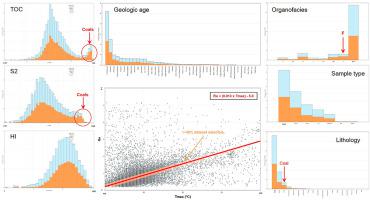Gas Science and Engineering ( IF 5.285 ) Pub Date : 2021-04-06 , DOI: 10.1016/j.jngse.2021.103946 Jonathan C. Evenick

|
For over 40 years Rock-eval pyrolysis data have been used to assess thermal maturity and source rock potential. There have been many published equations representing the transformation of Tmax to vitrinite reflectance (Ro) equivalence, but there has not been an attempt to investigate the empirical relationship using a large dataset. In this study, 33,732 approximately coincident measurements from 903 publications were utilized to test the applicability and practicality of Tmax, hydrogen index (HI), and production index (PI) as thermal maturity indicators. Additional sample metadata (sample type, lithology, organofacies, sample age, and other Rock-eval pyrolysis parameters) were also evaluated to ascertain if there were parameters that more frequently led to higher confidence measurements.
There was a positive correlation between Tmax and Ro, but there is considerable scatter in the data. A stronger trend was revealed in the mean, median, and mode values for each Tmax versus Ro pair that can be represented by the equation Ro = (0.013 x Tmax) - 5.0 with a R2 value of 0.22, which may be an improvement upon previously published equations. There was a breakdown in the correlation between Tmax and Ro at the beginning of the dry gas window (Ro values ~1.5; Tmax ~500 °C), which was not unexpected since the S2 peak significantly decreases through the wet gas window. Tmax-derived thermal maturity estimates are therefore most reliable between the values of ~430 °C and ~500 °C. It was also observed that coals with high total organic content (TOC) and S2 values had the least amount of data scatter among the different source rock organofacies. This may be due to the higher initial S2 values and these samples having a more prominent S2 peak allowing them to yield more reliable Tmax determinations.
中文翻译:

研究Tmax与镜质反射率之间的关系:热成熟度指标之间的经验比较
40多年来,岩石评估热解数据已用于评估热成熟度和烃源岩潜力。已经发表了许多表示将Tmax转换为镜质体反射率(Ro)等价物的方程,但是还没有尝试使用大型数据集来研究经验关系。在这项研究中,利用来自903个出版物的33,732个近似重合的测量值来测试Tmax,氢指数(HI)和生产指数(PI)作为热成熟度指标的适用性和实用性。还评估了其他样品元数据(样品类型,岩性,有机相,样品年龄和其他岩石评估热解参数),以确定是否存在更频繁地导致较高置信度测量的参数。
Tmax与Ro之间存在正相关,但数据中存在相当大的分散性。每个Tmax与Ro对的平均值,中位数和众数值显示出更强的趋势,可以用等式Ro =(0.013 x Tmax)-5.0表示,其中R 2值为0.22,可能是对先前发布的方程式的改进。在干气窗口开始时,Tmax与Ro之间的相关性出现了分解(Ro值〜1.5; Tmax〜500°C),这并不意外,因为S2峰在湿气窗口中显着降低。因此,在约430°C至约500°C的温度范围内,Tmax得出的热成熟度估算值最为可靠。还观察到,在不同烃源岩有机相中,具有高总有机物含量(TOC)和S2值的煤的数据散布量最少。这可能是由于较高的初始S2值,并且这些样品具有更突出的S2峰,从而使它们可以得出更可靠的Tmax测定值。


























 京公网安备 11010802027423号
京公网安备 11010802027423号